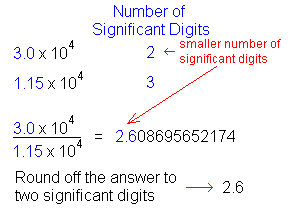Multiplication and Division |
![]()
Suppose that the population of a small city is about 3.0 x 104 people (that's 30,000 but we've written it in this way to emphasize that we are not sure about the population at the second digit in the number – we have two significant figures). In this same city there are 1.15 x 104 (or 11,500 with three significant digits) houses. Does this mean that there are an average of 2.608695652174 people in each house? That may be the mathematical answer you get by dividing the number of people by the number of houses, but it isn't a really meaningful answer. Where should we round it off?
That answer comes from the rule for significant digits used in multiplication and division:
| Round the answer to the shortest number of significant digits in the numbers you are multiplying or dividing. |
| The shortest number of significant digits is 2 (in the 3.0 x 104).
That means the proper way to report the answer is that there are an average of 2.6 people
per house in this city, which also has 2 significant digits. Here's how the calculation is done (color coding is used in the following diagram to illustrate the significant digits). The raw answer must be rounded to two significant digits since the shorter of the numbers we are using (3.0 x 104 people) has only two significant digits.
|
 |
Here are a few more examples (blue highlighting shows the smaller number of significant digits):
What is (104.250 x 2.26) / 15.553?
| Number | Number of |
Raw Answer | Rounded Answer |
| 104.250 | 6 |
( 235.605) /15.553 = 15.14852440044 |
15.1 |
| 2.26 | 3 |
||
| 15.553 | 5 |
What is (0.002450 * 0.1478) / 0.120?
| Number | Number of |
Raw Answer | Rounded Answer |
| 0.002450 | 4 |
(0.00036211) /0.120 = 0.003017583333333 |
0.00302 |
| 0.1478 | 4 |
||
| 0.120 | 3 |
Note in each case that the answer is rounded to the SMALLEST NUMBER of significant digits.
| How should the following be reported? Assume that each number is an experimental result with the correct number of significant digits. | |
(32.987 x 0.23) / 5.0000 = |
0.10246 x 0.0100 = |
There is no difference in dealing with numbers written in scientific notation. In fact, its easier, because there is never any confusion over whether the zeroes are significant or not. Just count the number of digits in the shortest experimental number, multiply (or divide) the numbers, and then round off the answer at the shortest number of digits.
What is (3.125 x 10-6) x (2.50 x 10-5)?
| Number | Number of |
Raw Answer | Rounded Answer |
| 3.125 x 10-6 | 4 |
7.8125 x 10-11 | 7.81 x 10-11 |
| 2.50 x 10-5 | 3 |
What is (1.3568 x 10-3 x 2.6554) / 3.266 x 10-7?
| Number | Number of |
Raw Answer | Rounded Answer |
| 1.3568 x 10-3 | 5 |
3.60284672 x 10-3 = 3.266 x 10-7 1.103137391304 x 104 |
1.103 x 104 |
| 2.6554 | 5 |
||
| 3.266 x 10-7 | 4 |
| How should the following be reported? Assume that each number is an experimental result with the correct number of significant digits. Make sure you answer in scientific notation (for example 1.23E-45). | |
3.2987 x 103 x 2.3 x 104 = |
1.02467 x 10-8 / 1.06 x 10-11 = |